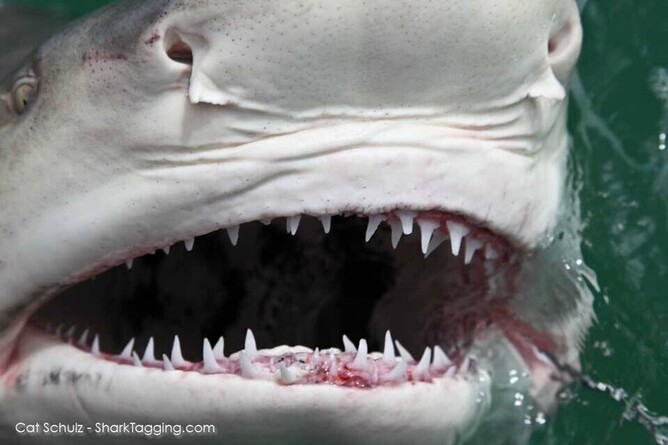This is the second in our series of 'I want to know about...' blogs. This one will cover the topic of sharks’ senses and the fascinating facts surrounding them.
An animal’s senses are vital for their survival in the wild. Many of them have evolved and adapted to help the animal thrive in its habitat and meet its needs. Senses have been specialised to deal with the environment and arm the animal with unique skills that can make it either an effective predator or an elusive prey. And sharks are no strangers to this.
When it comes to the ocean, sharks are a perfect example of apex predator. In the 450 million years that sharks have been around, they have spent that time wisely. Their senses are perfectly adapted for their environment and needs. Individually, each sense is apt at its job. Combined together, they make for an intimidating apex predator.
How well can sharks see?
It was generally once thought that sharks had poor eyesight, however this is most definitely false. In fact, it has been proven that they have a keen sense of sight that allows them to see well in dark or murky waters - up to 10 times better than humans!
What is a duplex retina?
Researchers have discovered that sharks have duplex retinas. This means that they have both rods and 1 cone cell. The rods allow the shark to distinguish between light and darkness, and the cone cell is supposed to allow the shark to detect colours. However, sharks are known to suffer from varying levels of colour blindness (tiger sharks especially). It is mainly thought that they are colour blind because they are entirely unable to see the colour red (because of the 1 cone).
This doesn’t mean that sharks can only see in black and white. They are able to see a range of colours. Interestingly, there are a few species of shark that seem to have a preference for the colour yellow, and this probably stems from their hunting behaviours - many tropical fish species come in a range of brilliant colours! Sharks liking yellow was a legitimate concern for the US Navy at one point, as they hoped to give their sailors yellow life vests - but feared this could put them in unforeseen danger!
The Size of Sharks' Eyes
Sharks aren’t necessarily known for their large, doe-eye qualities - not like many mammals. However, some species should definitely be known for having large eyes. The bigeye thresher, for example, is very appropriately named. As their name suggests, the eyes are very large - especially when compared to their overall body size. Interestingly, a 2006 study showed that the shark species with the largest eyes all lived in the top layer of the ocean - where waters are clearer and brighter. This study also explained that large eyes and pupils improved the sensitivity and the resolution of their vision. This is especially helpful when hunting their speedier prey (eg squid or tuna).
Explaining Tapetum Lucidum
Sharks are also known to have tapetum lucidum. This is a layer of reflective crystals, that lies just behind the retina - that’s why some shark eyes shine just like a cat’s! The mirror-like structure reflects incoming light through the retina for a second time, so that all available light is utilised by their photoreceptors. This feature allows them to see well at great depths where the light struggles to penetrate and it is estimated that sharks can see an estimated 10 times better than humans in dim lighting.
A tapetum lucidum can be counterproductive however. In bright conditions, they are rendered useless and can damage retinas. This is mainly why diurnal (opposite to nocturnal) animals do not have them. There are many shark species that choose to hunt during the night - and they have reached a stage of optimum potential. During the day, tiny molecules of dark pigment cover the tapetum lucidum which stop as much light penetrating and mirroring into the retina.
Why do some sharks have slit pupils?
Sharks’ eyes are also similar to cats in other ways too! You’ll find this commonly with reef sharks (and a few others) - they have slitted pupils. The majority of fish will have round pupils - so why do some sharks skip this trend? The definitive answer is actually still unknown for sure. It was actually the study of terrestrial animals that offers the most theories...
One explanation considers the physical properties of light - because of the way that light moves. Vertical slits perform better than round when wanting to gauge distance, and it is suggested that they may also help to create sharper colour images. For sharks that hunt in varied conditions, having slit pupils may be the product of adaptation evolution. The other theory is quite simple - a slit pupil can dilate more than a circular one!
While a human’s pupil can dilate only a mere tenfold from its smallest size, a slit pupil from a cat’s eye can dilate up to 135 times its size!
The function of the protective eyelid
Lastly, some species of shark are able to use a protective eyelid when hunting. The eye rolls backwards into the socket and is protected by this specialised eyelid; they can use this when fighting other animals or when they are feeding. A shark’s vision is monocular - this means that they are able to move each eye independently of each other, allowing for a much wider field of vision.
How effective is the shark's sense of smell?
Sharks are most definitely known for their superior sense of smell, and this is not exaggerated. They have 2 nasal openings located on the underside of their snout, these are known as ‘nares’. Each of their nares has two nasal openings. As they do not ‘breathe’ through their noses like terrestrial animals, water is constantly passing through their nares. Therefore, they are instantly aware if there is a change in the ‘smell’ of the water - mainly when looking for prey.
Sharks have an abundance of sensory cells within nasal sacs that send stimuli to the brain, which then interprets them and provides the shark with the information detected. This concerns location, distance and the nature of their prey. On average, 66% of their brain is dedicated to their olfactory senses. Sharks are famous for their effective ability to smell blood in the water at a distance; they are able to detect 1 part blood in 1 million parts water - this is about the equivalent of 1 teaspoon in a swimming pool.
What is the lateral line as a sensory organ?
All sharks (and most fish) have this sensory organ - it runs the entire length of their bodies and it consists of many pores filled with nerves that are able to detect subtle vibrations within the water. When a shark’s prey moves they will cause a vibration within the water that the shark’s lateral line will identify - vibrations travel much quicker in salt water too. The lateral line is lined with thousands of sensory hair cells that will move when the water vibrations hit - and this triggers nerve cells that transfer the location of the vibrations to the brain so that the shark can identify them and act on it. A shark can use this sense to identify the location and size of prey from hundreds of feet away.
Sharks also use their lateral lines for more basic needs - navigation. It allows them adept spatial awareness whereby their own movements will create waves that bounce off an object in the water - most oftenly reefs. This enables them to create a pressure map of their surroundings to use as they see fit.
What is the function of the ampullae of Lorenzini?
We briefly spoke of this sensory organ in our ‘Why are hammerhead sharks different?’ blog. These are specialised sensory organs that are located around the snout area of the shark. They are electroreceptors and the abundance of them forms a large network of nerves for the sharks to optimise.
Filled with a jelly-like substance, these organs are extremely sensitive and they are able to react to change in pressure, temperature and electrical activity. They are so sensitive that a shark can detect the miniscule movement of a fish that is buried deep in the sand beneath them. When hunting or searching for a potential mate, the shark will utilise this sensory organ to analyse where they can detect the most concentrated electrical pulses and change course as a result.
How important is a shark's sense of taste?
The overall sense of taste for sharks is not wildly developed since they don’t really use it. It’s not utilised in their hunting techniques particularly since all their other senses have evolved so well. They are known to take ‘test bites’ of their prey if they are unsure - and this does contribute to the high level of survivors of shark attacks - it is known they aren’t overly fond of the taste of us!
Can sharks hear well?
Sharks also have surprisingly well developed hearing. Their ears are located on either side of their head - two small holes just behind their eyes. With acute sense of hearing, sharks are very sensitive to low-frequencies and sounds made by wounded prey are particularly attractive to sharks. Their ears are made of 3 cartilage tubes. The tubes are lined with hair cells and filled with fluid - sound waves cause the small hairs to vibrate and the brain interprets the sound.
Enjoy this article and want to know more about Dive Bunnies?
Are you a new or novice diver and want to get more involved with Dive Bunnies? Why not join our Facebook Group and make some new friends - we would love to hear from you!









